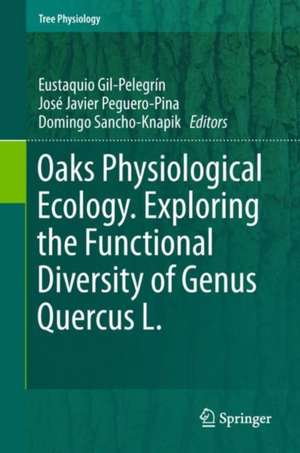Oaks Physiological Ecology. Exploring the Functional Diversity of Genus Quercus L.: Tree Physiology, cartea 7
Editat de Eustaquio Gil-Pelegrín, José Javier Peguero-Pina, Domingo Sancho-Knapiken Limba Engleză Hardback – 25 ian 2018
Such diversity and ecological amplitude makes genus Quercus an excellent framework for comparative ecophysiological studies, allowing the analysis of many mechanisms that are found in different oaks at different level (leaf or stem). The combination of several morphological and physiological attributes defines the existence of different functional types within the genus, which are characteristic of specific phytoclimates.
From a landscape perspective, oak forests and woodlands are threatened by many factors that can compromise their future: a limited regeneration, massive decline processes, mostly triggered by adverse climatic events or the competence with other broad-leaved trees and conifer species. The knowledge of all these facts can allow for a better management of the oak forests in the future.
| Toate formatele și edițiile | Preț | Express |
|---|---|---|
| Paperback (1) | 1828.11 lei 6-8 săpt. | |
| Springer International Publishing – 6 iun 2019 | 1828.11 lei 6-8 săpt. | |
| Hardback (1) | 1834.27 lei 6-8 săpt. | |
| Springer International Publishing – 25 ian 2018 | 1834.27 lei 6-8 săpt. |
Preț: 1834.27 lei
Preț vechi: 2236.91 lei
-18% Nou
Puncte Express: 2751
Preț estimativ în valută:
350.98€ • 367.49$ • 291.12£
350.98€ • 367.49$ • 291.12£
Carte tipărită la comandă
Livrare economică 09-23 aprilie
Preluare comenzi: 021 569.72.76
Specificații
ISBN-13: 9783319690988
ISBN-10: 3319690981
Pagini: 665
Ilustrații: VII, 547 p. 115 illus., 83 illus. in color.
Dimensiuni: 155 x 235 mm
Greutate: 0.95 kg
Ediția:1st ed. 2017
Editura: Springer International Publishing
Colecția Springer
Seria Tree Physiology
Locul publicării:Cham, Switzerland
ISBN-10: 3319690981
Pagini: 665
Ilustrații: VII, 547 p. 115 illus., 83 illus. in color.
Dimensiuni: 155 x 235 mm
Greutate: 0.95 kg
Ediția:1st ed. 2017
Editura: Springer International Publishing
Colecția Springer
Seria Tree Physiology
Locul publicării:Cham, Switzerland
Cuprins
1. Oaks and people: a long journey together; Eustaquio Gil-Pelegrín et al.- 2. An updated infrageneric classification of the oaks: review of previous taxonomic schemes and synthesis of evolutionary patterns; Thomas Denk et al.- 3. The fossil history of Quercus; Eduardo Barrón et al.- 4. Physiological evidence from common garden experiments for local adaptation and adaptive plasticity to climate in American live oaks (Quercus section Virentes): implications for conservation under global change; Jeannine Cavender-Bares, José Ramirez-Valiente.- 5. Oaks under Mediterranean-type climates: functional response to summer aridity; Eustaquio Gil-Pelegrín et al.- 6. Coexistence of deciduous and evergreen oak species in Mediterranean environments: costs associated with the leaf traits of both habits; Alfonso Escudero et al.- 7. The role of hybridization on the adaptive potential of Mediterranean sclerophyllous oaks: the case of the Quercus ilex x Q. suber complex; Unai López de Heredia et al.- 8. The xylem anatomy and function of oaks; Elisabeth Maria Rogier Robert et al.- 9. The role of mesophyll conductance in oak photosynthesis: among- and within-species variability; José Javier Peguero-Pina et al.- 10. Carbon losses from respiration and emission of volatile organic compounds – the overlooked side of tree carbon budgets; Roberto Salomón et al.- 11. Photoprotective mechanisms in the genus Quercus in response to winter cold and summer drought; José Ignacio García-Plazaola et al.- 12. Growth and growth-related traits for a range of Quercus species grown as seedlings under controlled conditions and for adult plants from the field; Rafael Villar et al.- 13. Drought-induced oak decline – factors involved, physiological dysfunctions, and potential attenuation by forestry practices; Jesús Rodríguez-Calcerrada et al.- 14. Physiological keys for natural and artificial regeneration of oaks; Jesús Pemán et al.- 15. Competition drives oak species distribution and functioning in Europe: implications under global change; Jaime Madrigal-González et al.- Index.
Textul de pe ultima copertă
Genus Quercus L. (oaks) comprises ca. 400 tree and shrub species with an outstanding role in the vegetation of the Northern Hemisphere. This genus has been culturally and economically linked to humans since millennia. Oaks can be found in very different phytoclimates, from temperate and subtropical forests to mediterranean evergreen woodlands. In parallel, this genus is characterized by a great functional and morphological diversity, with evergreen and sclerophyllous species to winter deciduous, malacophyllous ones. This fact has been food for thought in plant sciences as this book reflects. This book explores this great diversity in 15 chapters, covering the following aspects:
- Infrageneric classification and palaeontological records
- Functional response of oaks to environmental contrains, such as summer drought or winter cold, with special reference to water transport, gas exchange and photoprotective mechanisms
- Functional limitations to growth and regeneration
- Incidence of massive decline phenomena throughout the distribution range of oaks and attenuation methods
- The perspective of oak forest in the context of Global Change
Through the contributions of different field experts, this book aims to serve as a reference of the present knowledge about genus Quercus for researchers and students of biology or forestry.
- Functional response of oaks to environmental contrains, such as summer drought or winter cold, with special reference to water transport, gas exchange and photoprotective mechanisms
- Functional limitations to growth and regeneration
- Incidence of massive decline phenomena throughout the distribution range of oaks and attenuation methods
- The perspective of oak forest in the context of Global Change
Through the contributions of different field experts, this book aims to serve as a reference of the present knowledge about genus Quercus for researchers and students of biology or forestry.
Caracteristici
Deals with a highly relevant topic: the functional diversity and ecophysiology of oaks, which is an important tree group of the Northern Hemisphere The first comprehensive review of the knowledge of genus Quercus Most of its ca. 100 figures offer new conclusions from meta-analysis of previously published data Addresses a wide audience including graduate students, teachers, scientists and professionals dealing with forestry, plant ecophysiology, oak biodiversity and taxonomy and Biogeography of genus Quercus







